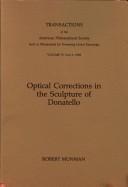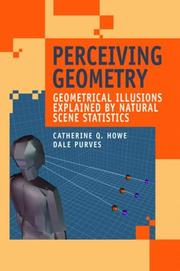| Listing 1 - 10 of 20 | << page >> |
Sort by
|
Book
ISBN: 0500270929 Year: 1977 Publisher: London : Thames and Hudson,
Abstract | Keywords | Export | Availability | Bookmark
 Loading...
Loading...Choose an application
- Reference Manager
- EndNote
- RefWorks (Direct export to RefWorks)
Optical illusions --- Visual perception --- Illusions d'optique --- Perception visuelle --- Optics, Psychological --- Vision --- Perception --- Visual discrimination --- Illusions, Optical --- Hallucinations and illusions --- Physiological optics --- Psychological aspects
Book
ISBN: 0716721333 0716721341 Year: 1990 Publisher: New York, NY : W. H. Freeman,
Abstract | Keywords | Export | Availability | Bookmark
 Loading...
Loading...Choose an application
- Reference Manager
- EndNote
- RefWorks (Direct export to RefWorks)
Optical illusions --- Visual perception --- Illusions d'optique --- Perception visuelle --- #TELE:MI2 --- Optics, Psychological --- Vision --- Perception --- Visual discrimination --- Illusions, Optical --- Hallucinations and illusions --- Physiological optics --- Psychological aspects
Book
ISBN: 0470265221 Year: 1978 Publisher: Hillsdale Erlbaum
Abstract | Keywords | Export | Availability | Bookmark
 Loading...
Loading...Choose an application
- Reference Manager
- EndNote
- RefWorks (Direct export to RefWorks)
Optical illusions --- Psychological aspects --- Illusions. --- Visual Perception. --- 159.931 --- -Illusions, Optical --- Hallucinations and illusions --- Physiological optics --- Visual perception --- Perception, Visual --- Perceptions, Visual --- Visual Perceptions --- Vision, Ocular --- Autokinetic Illusions --- Effect, Autokinetic --- Illusions, Auditory --- Illusions, Kinesthetic --- Illusions, Tactile --- Illusions, Visual --- Autokinetic Effect --- Auditory Illusion --- Auditory Illusions --- Autokinetic Effects --- Autokinetic Illusion --- Effects, Autokinetic --- Illusion --- Illusion, Auditory --- Illusion, Autokinetic --- Illusion, Kinesthetic --- Illusion, Tactile --- Illusion, Visual --- Illusions, Autokinetic --- Kinesthetic Illusion --- Kinesthetic Illusions --- Tactile Illusion --- Tactile Illusions --- Visual Illusion --- Visual Illusions --- Zien. --- Optical illusions. --- Psychological aspects. --- -Zien. --- 159.931 Zien. --- Illusions --- Visual Perception --- Illusions, Optical --- Zien --- Visual Processing --- Processing, Visual
Book
ISBN: 9780805092813 9780312611675 Year: 2010 Publisher: New York, N.Y. Henry Holt and Co
Abstract | Keywords | Export | Availability | Bookmark
 Loading...
Loading...Choose an application
- Reference Manager
- EndNote
- RefWorks (Direct export to RefWorks)
Stephen Macknik and Susana Martinez-Conde, the founders of the new discipline of neuromagic, have convinced some of the world's greatest magicians to allow scientists to study their techniques for tricking the brain. This book is the result of the authors' yearlong, world-wide exploration of magic and how its principles apply to our behavior. Magic tricks fool us because humans have hardwired processes of attention and awareness that are hackable--a good magician uses your mind's own intrinsic properties against you. Now magic can reveal how our brains work in everyday situations. For instance, if you've ever bought an expensive item you'd sworn you'd never buy, the salesperson was probably a master at creating the "illusion of choice," a core technique of magic. The implications of neuromagic go beyond illuminating our behavior; early research points to new approaches for everything from the diagnosis of autism to marketing techniques and education.--From publisher description.
Cognitive psychology --- Physiology of nerves and sense organs --- Magic tricks. --- Neurosciences. --- Optical illusions. --- Magic tricks --- Neurosciences --- Optical illusions --- Neural sciences --- Neurological sciences --- Neuroscience --- Medical sciences --- Nervous system --- Conjuring --- Legerdemain --- Parlor magic --- Prestidigitation --- Sleight of hand --- Tricks --- Illusions, Optical --- Hallucinations and illusions --- Physiological optics --- Visual perception

ISBN: 0871697521 Year: 1985 Volume: vol 75, part 2
Abstract | Keywords | Export | Availability | Bookmark
 Loading...
Loading...Choose an application
- Reference Manager
- EndNote
- RefWorks (Direct export to RefWorks)
Optical illusions --- Visual perception --- Optics, Psychological --- Vision --- Perception --- Visual discrimination --- Illusions, Optical --- Hallucinations and illusions --- Physiological optics --- Psychological aspects --- Donatello, --- Bardi, Donato de', --- De Bardi, Donato, --- Di Betto Bardi, Donato di Niccolò, --- Bardi, Donato di Niccolò di Betto, --- Betto Bardi, Donato di Niccolò di, --- Criticism and interpretation.
Book
ISBN: 0387965181 9780387965185 3540965181 9783540965183 1461291445 1461247608 Year: 1987 Publisher: New York, NY : Springer-Verlag,
Abstract | Keywords | Export | Availability | Bookmark
 Loading...
Loading...Choose an application
- Reference Manager
- EndNote
- RefWorks (Direct export to RefWorks)
Optical illusions
---
Visual perception
---
Optics, Psychological
---
Vision
---
Perception
---
Visual discrimination
---
Illusions, Optical
---
Hallucinations and illusions
---
Physiological optics
---
Psychological aspects
---
Visual perception.
---
Optical illusions.
---
Perception visuelle.
---
Illusions d'optique.
---
Illusions.
---
Optical Illusions.
---
Visual Perception.
---
Visuelle Wahrnehmung.
---
Optische Täuschung.
---
Garden City
Book
ISBN: 0710008686 Year: 1982 Publisher: London : Routledge and Kegan Paul,
Abstract | Keywords | Export | Availability | Bookmark
 Loading...
Loading...Choose an application
- Reference Manager
- EndNote
- RefWorks (Direct export to RefWorks)
159.931 --- 612.843.7 --- Optical illusions --- #SBIB:309H526 --- Illusions, Optical --- Hallucinations and illusions --- Physiological optics --- Visual perception --- Zien. --- Visual perception. Spatial vision. Binocular vision. Stereoscopy --- Psychologie van de audiovisuele boodschap --- Optical illusions. --- 612.843.7 Visual perception. Spatial vision. Binocular vision. Stereoscopy --- 159.931 Zien. --- Zien

ISBN: 0262611058 026211173X 9780262611053 Year: 1996 Publisher: Cambridge (Mass.) : MIT press,
Abstract | Keywords | Export | Availability | Bookmark
 Loading...
Loading...Choose an application
- Reference Manager
- EndNote
- RefWorks (Direct export to RefWorks)
Illusions d'optique --- Sexualité dans l'art --- Optical illusions. --- Sexualité dans l'art --- Rosalind E.Krauss --- Artists --- Optical illusions --- Visual perception --- 7.01 --- kunst --- kunsttheorie --- modernisme --- Optics, Psychological --- Vision --- Perception --- Visual discrimination --- Illusions, Optical --- Hallucinations and illusions --- Physiological optics --- Art --- Psychology --- Psychological aspects --- Visual perception. --- Psychology. --- Sex in art --- Perception visuelle --- Artistes --- Psychologie --- CDL

ISBN: 0123136016 0123136024 1322459983 1483259560 Year: 1980 Volume: 1 Publisher: New York (N.Y.): Academic press
Abstract | Keywords | Export | Availability | Bookmark
 Loading...
Loading...Choose an application
- Reference Manager
- EndNote
- RefWorks (Direct export to RefWorks)
Visual Perception --- Optical illusions --- Art --- Psychology --- 159.931 --- 7.01:003 --- Visual perception --- -#SBIB:309H526 --- Optics, Psychological --- Vision --- Perception --- Visual discrimination --- Zien. --- Semiotiek van kunst en esthetiek --- Addresses, essays, lectures --- Psychologie van de audiovisuele boodschap --- Psychological aspects --- -Optical illusions --- -Illusions, Optical --- Hallucinations and illusions --- Physiological optics --- Art, Occidental --- Art, Visual --- Art, Western (Western countries) --- Arts, Fine --- Arts, Visual --- Fine arts --- Iconography --- Occidental art --- Visual arts --- Western art (Western countries) --- Arts --- Aesthetics --- -Addresses, essays, lectures --- Visual perception. --- Optical illusions. --- Psychology. --- -Zien. --- 7.01:003 Semiotiek van kunst en esthetiek --- 159.931 Zien. --- -7.01:003 Semiotiek van kunst en esthetiek --- Illusions, Optical --- #TELE:d.d. Prof. A. J. J. Oosterlinck --- #SBIB:309H526 --- -Addresses, essays, lectures. --- Zien --- -Art, Occidental --- Psychology -&delete& --- Art, Primitive --- -Optics, Psychological --- -Psychology

ISBN: 1280337427 9786610337422 0387254889 0387254870 1441938001 Year: 2005 Publisher: New York, NY : Springer,
Abstract | Keywords | Export | Availability | Bookmark
 Loading...
Loading...Choose an application
- Reference Manager
- EndNote
- RefWorks (Direct export to RefWorks)
Understanding vision, whether from a neurobiological, psychological or philosophical perspective, represents a daunting challenge that has been pursued for millennia. During at least the last few centuries, natural philosophers, and more recently vision scientists, have recognized that a fundamental problem in biological vision is that the physical sources underlying sensory stimuli are unknowable in any direct sense. In vision, because physical qualities are conflated when the 3-D world is projected onto the 2-D image plane of the retina, the provenance of light reaching the eye at any moment is inevitably uncertain. This quandary is referred to as the inverse optics problem. The relationship of the real world and the information conveyed to the brain by light present a profound problem. Successful behavior in a complex and potentially hostile environment clearly depends on responding appropriately to the sources of visual stimuli rather than to the physical characteristics of the stimuli as such. If the retinal images generated by light cannot specify the underlying reality an observer must deal with, how then does the visual system produce behavior that is generally successful? Perceiving Geometry considers the evidence that, with respect to the perception of geometry, the human visual system solves this problem by incorporating past human experience of what retinal images have typically corresponded to in the real world. This empirical strategy, which is documented by extensive analyses of scene geometry, explains many otherwise puzzling aspects of what we see (i.e., the so-called "geometrical illusions"), providing the best indication to date as to how perceptions of the geometrical aspects of the world are actually generated by the brain.
Optical illusions. --- Geometrical optics. --- Visual perception. --- Optics, Psychological --- Vision --- Perception --- Visual discrimination --- Optics, Geometrical --- Optics --- Illusions, Optical --- Hallucinations and illusions --- Physiological optics --- Visual perception --- Psychological aspects --- Neurosciences. --- Neurobiology. --- Consciousness. --- Psychology, clinical. --- Ophthalmology. --- Cognitive Psychology. --- Neuropsychology. --- Clinical psychology. --- Medicine --- Eye --- Apperception --- Mind and body --- Philosophy --- Psychology --- Spirit --- Self --- Neurosciences --- Neural sciences --- Neurological sciences --- Neuroscience --- Medical sciences --- Nervous system --- Psychiatry --- Psychology, Applied --- Psychological tests --- Diseases --- Cognitive psychology. --- Neurophysiology --- Psychophysiology --- Psychology, Cognitive --- Cognitive science
| Listing 1 - 10 of 20 | << page >> |
Sort by
|

 Search
Search Feedback
Feedback About UniCat
About UniCat  Help
Help News
News